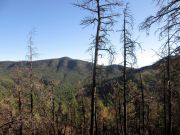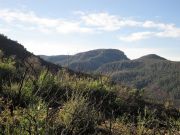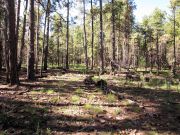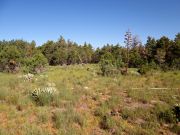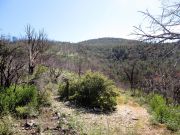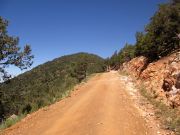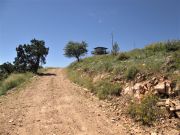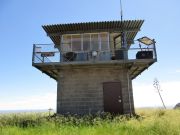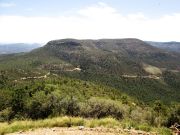
The Mountains of Arizona
• www.surgent.net
|
|
Horse Mountain • Lookout Two peaks about 3 miles from one another in the northern Sierra Ancha are named McFadden, after an old rancher named Bill McFadden from the early 20th Century. The southern peak is called McFadden Horse Mountain, and the northern one simply McFadden Peak. There is an active lookout tower on top of McFadden Peak. I have not hiked since June, and with the weather hot for at least another month, things did not look promising. But we had a "nice" spell for a few days, where temperatures in the Phoenix area barely breached 100 degrees, and there were no storms. The air mass was dry and stable, more like October weather. I figured it may be pleasant at the mid-elevations (6000 feet and above), so I took advantage of this opportunity and hiked these two peaks.
Date: August 19, 2017
• Elevation: 7,510 feet
• Prominence: 870 feet
• Distance: 5 miles
• Time: 3 hours, 30 minutes
• Gain: 1,832 feet
• Conditions: Clear, dry and pleasant
Arizona
•
Main
•
PB (Horse)
•
PB (Peak)
I was on the road at 4 a.m., arriving into Globe about 5:30 where I got snacks and drinks at the Fry's grocery store. I then followed AZ-188 north to where AZ-288 splits, then AZ-288 north into the Sierra Anchas. I kept a slow pace and enjoyed the views and cool air. By 6:45 a.m., I arrived to the meager parking area for the McFadden Horse Mountain Trail (#146 said the sign, #145 said the map). The trailhead is nearby milepost 288. I got dressed and my pack together, and was walking on the trail at 7 a.m. sharp.
I deliberately went slow given I had not hiked in two months. I got into a breathing rhythm quickly and my legs felt good, but my ankles had become used to city-walking, so I was turning them regularly on the rocky, gravelly trail.
This trail appears to be an old road. It also appears to not be looked after. Erosion had dug in v-shaped channels down its center. It was steep and rubbly. I stayed on it for about a mile, gaining about 650 feet. The sun was still behind the mountain mass to the east, but was now just starting to rise above it. The temperatures were pleasant, and the humidity was low.
I then came to a second trail, called Cienega Trail they say. All I saw was an old sign. It was the right trail, so I started on it, then immediately lost it in the brush. I would pick a line that felt right, barge through waist-high scrub, then find what looked like more trail again, only to lose it ... again. This went on for about 30 minutes. I knew to stay on the ridge itself, so it was failsafe. But I really did not want to be dealing with brush the whole way up.
After gaining about 300 feet, I found the trail, and here, it was a little more defined. I was able to get up another couple hundred feet to top out on a small rise. Then the trail ended again. However, I found a foot-high cairn and a weak path leading from it, so I followed it. I spied more cairns, and slowly made forward progress.
The next half mile was mostly level, the meager trail now lined by occasional cairns and two-foot high grasses and shrubs, often hiding the cairns. Often, the only hint of a trail was a cleared lane through the trees. I passed the Sierra Ancha Wilderness sign along the way.
Soon, the trail started steeply up the west-facing slopes of McFadden Horse, zig-zagging a few times. Cairns helped in spots, and I even built a few more for the next visitor in six months. Finally, I could see a three-foot high cairn up ahead. I was now on top the plateau.
The map shows the trail heads east a bit then ends, but the route by now is a sequence of large cairns, no actual path being evident. These cairns trend south and in another half-mile, had arrived onto the "top". I was inside the 7,480-foot contour that covers about 10 acres.
I stayed on the path until it dropped, so then I headed back, then wandered west into the open forest to look for any other high spots, or maybe a cairn or sign or something that was the official summit marker. I walked until I could see the land drop to the south and west. I then walked back to the path, and really couldn't tell where the highest ground was. My instinct says that it may have been about 500 feet west of the path, but the difference is just a few feet at best.
I didn't stop here to celebrate. I decided this was good enough, so I walked back, retracing my route, to where the path, such as it was, started to head back down the slopes. Here, I took a break to drink and relax.
The hike down went slightly better, since I could glean the trail slightly better from higher up. The rocks were a nuisance and I turned my ankles about 50 times. Back on that first trail (the old road), I slipped often on the gravel, almost doing the splits at one point. I was back to my vehicle at 10:30 a.m.. I piled in and rested briefly, then drove up the road to my next objective, McFadden Peak.
This hike covered about 5 miles with just under 1,900 feet of elevation gain, so I got a good workout, but the overgrown and eroded trails were unpleasant. It seems very few people hike this trail. There are some Indian ruins on the far end of the plateau, but I did not visit them. The peak gets its odd name after McFadden the rancher used it as a horse pasture, this according to Will Barnes' Arizona Place Names.
Date: August 19, 2017
• Elevation: 7,135 feet
• Prominence: 786 feet
• Distance: 2.6 miles
• Time: 90 minutes
• Gain: 786 feet
• Conditions: Clear and very warm
The drive to the base of McFadden Peak took just a few minutes. I was mildly surprised to see the gate open and briefly considered driving up the road partways. But I had psyched myself up for a hike, so I parked at the base. Besides, the hike wasn't too long. I was already dressed and ready so I just locked the car and started walking.
The hike up went well. After this morning's hike on loose gravel and knee-high scrub, walking this wide road was welcome, if boring. It was sunny and warm by now, about in the mid-80s. I kept a consistent pace and stopped now and then in the shade. In about 40 minutes, I had rounded the bends and was approaching the top.
I saw the lookout man doing his rounds and got his attention. He was friendly and said I was welcome to walk up to the viewing platform. I took him up on his offer, and visited with him for about 30 minutes. The views were very good, as one would expect.
The man's name was Jim, a botanist by trade. He said he gets about 2 people a day visiting, lots of hunters and a few hikers. There weren't any fires to worry about right now, so he told me some stories of his time up at the lookout. I had a pleasant visit and enjoyed my time up there, but knew I should be moving along. I figured 30 minutes was reasonable. He was a very personable man.
The 30 minutes of standing around had made my leg muscles get tight, so I carefully climbed down the lookout's steps, then slowly walked the road back to my car. The walk out took about 20 minutes, with gravity aiding me. It was hot by now, and I was also battling a sore toe. I was back to my car about 12:30 p.m., my car's thermometer saying it was about 90 degrees here.
I was now done with my two hikes, having put on about 7.5 miles on my feets and about 2,600 feet of elevation gain. I felt tired and happy, plus sweaty, hungry and thirsty. I changed into driving clothes and started the slow drive south to Globe.
The drive out was scenic, and I went slow, there being no traffic to hassle me. In an hour, I was back to the Salt River, then soon back on to state route AZ-188 and into Globe. What I really wanted was a minimart to stop and get drinks, but the one or two I saw were jam-packed with cars, so I passed them and figured I could get drinks in Superior. But that didn't happen, so I drove all the way back to Apache Junction where I stopped for a Subway meal and a chance to clean up and rehydrate. I was back to my home by 3 p.m.
These were my first hikes on over two months and I felt happy to get back into the flow of things. A lot happened in those two months, much of it unpleasant, so allowing my brain time off to just look at trees, sky and scrub was what I needed.
|
|
